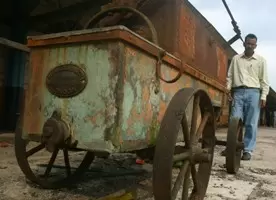Tracking the history of the railways is Rajendra Aklekar’s passion

11-February-2011
Vol 2 | Issue 6
He is perhaps a man who knows too much about the Indian Railways. Meet journalist Rajendra Aklekar, an assistant editor with the English daily DNA in Mumbai, whose passion for railways gave way for the creation of The Bombay Railway History Group in 2002.
“Trains fascinated me right from my childhood, as I used to travel by train to school from my home in Kurla to Matunga in the early 1990s. After school I always hung out with a bunch of friends near the tracks watching the speeding trains. The more I saw them, the greater was the interest in them and I started reading books on the subject,” he says.
He collected a lot of information from the books. “I learnt that the railway in Bombay was not only the country's first railway, but also the first railway in this part of the world, in Asia. While travelling by train daily, I noticed many of the relics and monuments that had been mentioned in the descriptive journey of the first train, in the books. More than 150 years later, many things were still there... as if the ghost of the first railway still lingered there.”
 |
|
Railway Tracked: Rajendra Aklekar, besides an old rail fire extinguisher (water tank) wagon at Lonavala
|
It triggered the interest in him to explore further and he decided to walk up the entire distance on foot between CST (Chatrapati Shivaji Terminus) to Thane and Churchgate to Virar. “It took several days and months. But station-by-station, I covered it all, discovering many stunning old relics in the process. The then general manager of Western Railways, Anoop Krishna Jhingron, included an entire chapter of the documentation in his book – an official publication of the Railways.”
Years ago, the now 36-year-old Aklekar used to write a column in a local newspaper on history and heritage of railway stations in Mumbai. In 2002, he formed the Bombay Railway History Group to research further on the subject and has since been independently involved in documenting and researching the history of the Great Indian Peninsula Railway (GIP Railway), which is today known as the Central Railway with its head office at the erstwhile Victoria Terminus (Chatrapati Shivaji Terminus building), a world heritage site.
The Bombay Railway History Group began simply as a mailing list of group of people interested in Bombay's railway heritage in specific and railway history and heritage in general. One of the prime activities of the group is to inform and alert the concerned railway authorities about unnoticed relics lying along the lines, document them, and make appeals for their conservation.
Aklekar first began to share his enthusiasm for the railways in the media as a journalist with The Daily in 1997-’98, after he convinced Rusi Karanjia to let him run a column on the history of the railways.
To learn more about heritage activities and get involved in it, he took formal training in museology and conservation and restoration from the Chhatrapati Shivaji Vaastu Sangrahalaya (formerly Prince of Wales Museum of Western India).
“I have started writing a book. I have plans for setting up a book archive cum museum,” says Aklekar, who has helped in the making of some documentary films on the railways, including, ‘Tracks of Empire,’ by Johan Sergeant for BBC, and Bombay Rail.
















